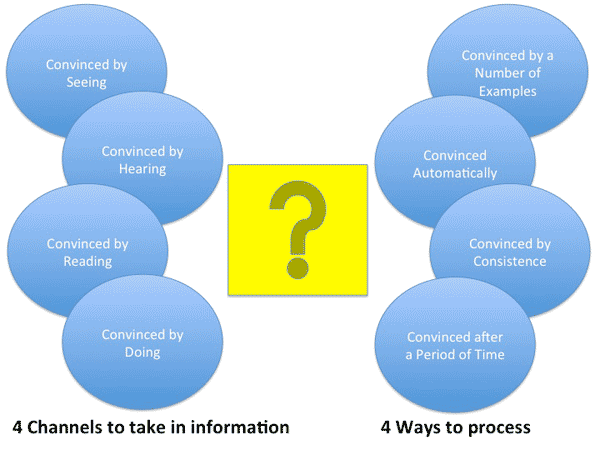governance
Enabling Better Decisions at the Board Table
Published: September 9, 2013
Read Time: 7 minutes

High performing boards make decisions
At the recent Better Boards Conference, Nonie Wales and Morri Young of Matrix on Board gave a presentation on ‘Board Business: Sharing the load’.
They defined a high performing board as one that:
- is well lead
- makes decisions
- has good information
- all members participate in board business
Whilst other defining characteristics of a high performing board could be added to this list, few would disagree with what they outlined.
Making ‘good decisions’ is easier said than done. In fact making any decisions in a group setting can be easier said than done.
If your board sometimes struggles to reach decisions, it might be helpful for you to have an understanding of Convincer Strategies. This article explains why you might find coming to decisions challenging, and provides strategies to ensure you have the 8 Convincer Patterns covered.
What is a Convincer Strategy?
Your Convincer Strategy comes from the eight Convincer metaprograms. Metaprograms are the unconscious sorting filters in our mind that determine what we pay attention to in our environment – what we filter into and out of our experience. This sorting function happens outside our conscious awareness and drives how we think, feel and act. 1
Everyone has their own Convincer Strategy
I have my own preferred process for making decisions. I like to hear about the topic (asking for referrals from trusted colleagues is the way I typically buy services), and then I want to see how it will work. Assuming I have trust in the sources, I can then take a limited amount of information, extrapolate to fill the gaps, and make a decision quickly. Doesn’t everybody work this way?
Actually, no they don’t! Assuming that people make decisions in the same way as you can make reaching a decision at the board table challenging.
There are the four ways we take in information to make a decision:
- Convinced by Seeing: Some people must be able to see something to get convinced. They may focus on the pictures, ask for a diagram, or want to draw out the process on a whiteboard.
- Convinced by Hearing: Others want to hear about something in order make a confident decision. They may ask their colleagues for recommendations, or request that you ‘talk them through’ the plan.
- Convinced by Reading: These people must read information or instructions in order to decide with confidence. They might prefer email over telephone conversation so that they can read the flow.
- Convinced by Doing: Some folks want to actually do it in order to be convinced. They may want to try it out for themselves. In board discussions they will need to ‘get a feel for’ how things will operate after the decision is made.
Of course taking in information is only part of the story. We also have internal processes for becoming convinced in order to make a decision:
- Convinced by Number of Examples: Some people must have the data a particular number of times to be convinced.
- Convinced Automatically: Others need only partial information and they quickly extrapolate the rest of the information and decide based on their projections.
- Convinced by Consistency: There is a group of people who are never quite convinced, and need to get information every single time to remain somewhat convinced.
- Convinced after a Period of Time: These people need to have the data remain consistent for period of time, or need a period of time to reflect before they are ready to decide.
When you reach an impasse, and the board is unable to make a decision, it is likely that at least one influential director has not had their personal decision-making strategy satisfied.

Just last week
Last week I was working with a team to enhance their capacity as a leadership unit. Decision making strategies turned out to be a hot topic for them. (We quantify this via Motivational Profiling that measures 48 motivational and attitudinal patterns, including the 8 ‘Convincer Patterns’ outlined above.)
Josh 2 has a very strong preference for Convinced by Doing, and others in the team could not understand why he needed to either take action or experience others doing something in order to be confident of a decision. The whole team is high on Convinced by Hearing, so discussions were important in their decision-making process. All are demotivated by Convinced by Reading – no decision-making papers for this group!
Mark is Convinced Automatically, and after a short discussion is ready to make a quick decision. He finds the decision-making pace of the rest of the team incredibly frustrating. Not understanding why, and without the skills to influence an immediate decision, his frustration sometimes translates into what his colleagues described as ‘impetuousness’ and ‘emotiveness’ that detracts from team processes.
Brian and Josh are both motivated by Convinced after a Period of Time. Whilst both can make immediate decisions if necessary, they share a strong preference to reflect on decisions wherever possible. Mark experiences Brian and Josh’s behaviour as ‘blocking’ and ‘wasting time’.
Nancy, is strong on Convinced by Consistency and needs evidence presented again every time a decision is made. After making a decision, she often wonders if that was the right decision and whether a rethink is necessary. Her colleagues interpret her constant need to check as a lack of trust.
Decision-making was much harder than it needed to be! Before our workshop none of this team had a conscious awareness of their own Convincer Patterns.
Armed with this new understanding, team decisions will now be informed by awareness Convincer preferences.
Helping your board make decisions
Think back to the last time your board got stuck on a decision. What was going on? What Convincer Patterns were at play? What could you do more effectively next time?
Here are three actions you can take to build the decision-making culture of your board:
- Review the 8 Convincer Strategies outlined above to diagnose your own decision-making strategy. Now you’re ready to watch for bias and ensure that you cater to your non-preferred styles when seeking a decision from others.
- Arrange Motivational Profiling and a team workshop for your board to build awareness and increase board effectiveness.
- Follow the simple strategies below to ensure you have all 8 bases covered in your board decision making processes:
| Where someone is convinced by…. | then …. |
| Seeing | Include sufficient pictures and diagrams in your board papers. |
| Hearing | Ensure sufficient time in board meetings for focused discussion. Invite a guest with expertise in the area of the decision to speak. (Don’t be surprised at a reluctance to read board papers!) |
| Reading | Provide quality board papers well in advance to allow sufficient time for reading. Where a decision must be made out-of-meeting by conference call, outline the rationale by email in advance. |
| Doing | Offer opportunities to ‘try it out’. Conduct site visits. Lead a discussion to the future and how we will ‘feel’ once this decision is made and implemented. |
| Number of Examples | Provide a number of examples and/or case studies in your board papers or presentations. |
| Automatically | Be aware that they may make an immediate decision – sometimes even before the first example is completed. They are not being dismissive; they are simply ready to decide now. Move decisions quickly (or help them to understand that others need more time/examples before a collective decision can be made). |
| Consistency | Provide supporting documentation every time, even when similar information has been provided in the past. Be cautious about interpreting lack of comfort with making a decision as a lack of confidence. |
| After a Period of Time | Ensure sufficient time between receipt of board papers and decision time. On significant decisions, schedule a discussion at one meeting and a decision at the next to allow processing time. |
What is your convincer strategy? How effective is your board’s current decision making strategy? What will you do to build the decision-making culture of your board?
-
Metaprograms are an underpinning concept of NeuroLinguistic programming (NLP). NLP is the study of human excellence: neuro is thinking, linguistic is language, and programming is the doing. Motivational Profiling, through the inventory of Work Attitudes and Motivations measures 48 motivational patterns or metaprograms, including the Convincer patterns. ↩︎
-
Note: Case studies have been altered in name and in other identifying factors so as to preserve client anonymity without distorting the essential reality of the story. ↩︎
Share this Article
Recommended Reading
Recommended Viewing
Author
-
Consultant
-
- About
-
Corrinne enables her clients to achieve objectives faster through embracing the fearless leadership that results from the intersection of purpose, communication and motivation. She is passionate about enabling effective leadership through decoding the below conscious influence of motivational patterns. Corrinne is a co-author of ‘Peak Performance Patterns – Cracking the code for workplace performance’ and the forthcoming book ‘Shift: Making the change that matters’.
Found this article useful or informative?
Join 5,000+ not-for-profit & for-purpose directors receiving the latest insights on governance and leadership.
Receive a free e-book on improving your board decisions when you subscribe.
Unsubscribe anytime. We care about your privacy - read our Privacy Policy .







